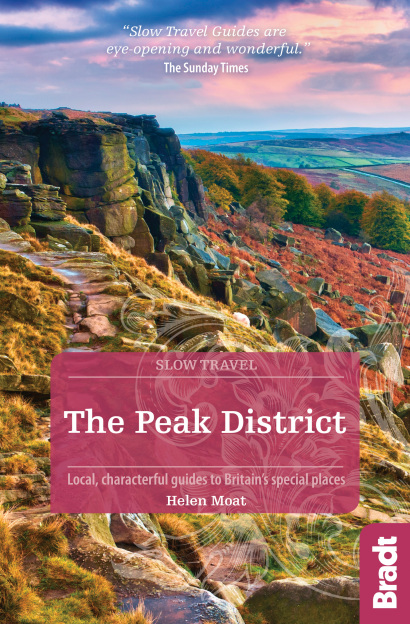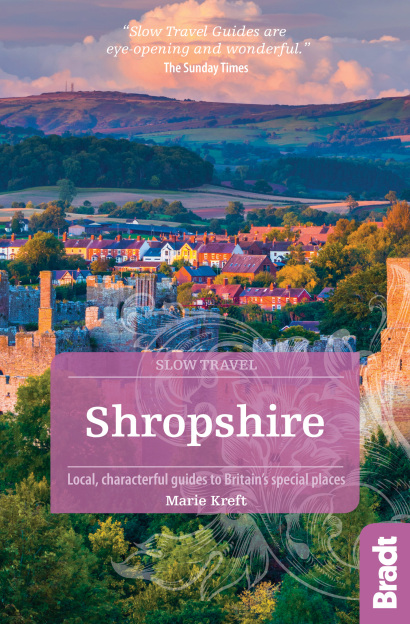Explore England’s history with this selection of our some of the best ruins in the country. Castles, abbeys, Roman ruins and even RAF bases, there’s something here for almost everyone.
Whitby Abbey, Yorkshire
If ever a place could be described as having a chequered history, then this abbey in the North York Moors is it: founded by Saxons, destroyed by Vikings, rebuilt by Normans, dismantled by Tudors and bombarded by Germans.
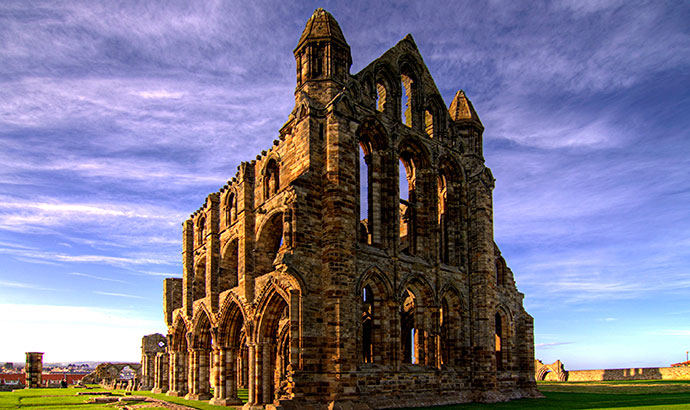
This won’t be the final chapter: when the abbey was built it stood half a mile from the sea but in the intervening 900 years that distance has been reduced to 200 yards by the erosional power of the North Sea. In a few more hundred years, the stones of the abbey will be on the beach growing seaweed.
Tintagel Castle, Cornwall
From the Cornish clifftop path, the once fortified island reveals itself in all its natural grandeur. It has been well established that a 5th- or 6th-century monastery and trading post stood here, and relics of Mediterranean oil and wine jars have been found.
The Arthurian connection is largely due to Geoffrey of Monmouth’s 12th-century manuscript, which makes Tintagel the place of Arthur’s conception, and a century later Prince Richard – the Earl of Cornwall responsible for building Launceston Castle’s stone walls – used the myth to reinforce his own magisterial status in Cornwall.
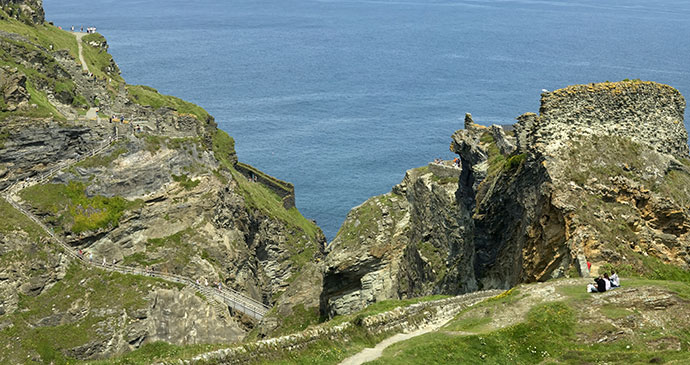
The ruins seen today are the remnants of the castle Prince Richard built. But Arthur’s name remains more potent at Tintagel than Richard’s; and when a piece of inscribed slate was discovered during excavations on the island in 1998, pro-Arthurian excitement knew no bounds. In Latin, it read: ‘Artognou, father of a descendant of Coll, has had [this] made.’ Cynics may shrug, but in the end, the place, in all its wild and windblown glory, is bigger than the academic disputes that surround it.
Moreton Corbet Castle, Shropshire
In the Shropshire village of Moreton Corbet, this ruined shell of a medieval stronghold and an ambitious Italianate mansion begun in the late 15th century.
This is a romantic and peaceful picnic spot on the right day, but watch out for the ghost of Paul Holmyard, a Puritan cast out by his neighbour Sir Vincent Corbet.
Sherborne Old Castle, Dorset
This atmospheric ruin lies to the east of the Dorset town, in the grounds of the new Sherborne Castle, and is all that remains of the original, which was destroyed by Cromwell’s troops during the Civil War. It reportedly took 16 days for Cromwell’s men to bring the castle down in 1645; only the imposing gatehouse, parts of the keep and the outer walls survive, surrounded by a moat.
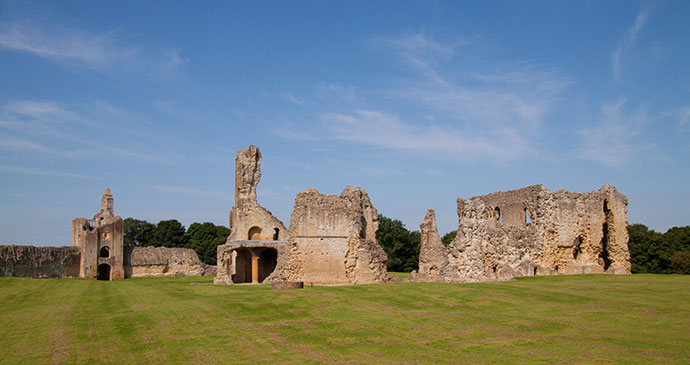
The entrance passes over a modern bridge with the piers of the medieval one beneath it. It is a serene spot with fine beech trees, views of the surrounding countryside and the town. It oozes history and mystery, conjuring up images of medieval banquets and battles.
Burgh Castle, Norfolk
The impressive Roman ruins of Burgh Castle (originally known as Gariannonum) loom above the confluence of the Yare and Waveney in Norfolk. With massive 3rd-century walls sloping at a precarious angle above the river and reed beds, it’s certainly an impressive spot (free access) and well worth the effort of walking to along the estuary bank from Yarmouth.
The castle’s crucial strategic position is self-evident; these massive brick and flint fortifications were abandoned at the beginning of the 5th century when the Romans finally thought better of occupying such intractable northern territory.
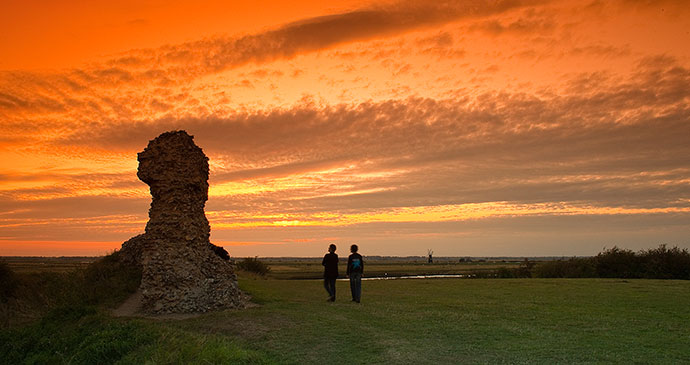
It is possible that Burgh Castle also marks the location of Cnobheresburg, a 7th-century monastery founded by Saint Fursa, the first Irish missionary in southern England. Whether or not the monastery’s actual site was within these walls or elsewhere on this coast is open to debate; either way, subsequent attacks by Danish raiders soon encouraged Fursa to decamp to the relative safety of France.
St Edmund’s Abbey, Suffolk
St Edmund’s Abbey in Suffolk was destroyed at the time of the Dissolution, but the pleasant Abbey Gardens, created in 1831 with flower beds and ornamental trees, that occupy its former expansive grounds provide a restful space to wander in and contemplate the time when the site may have been the East Anglian equivalent of Glastonbury.
Strolling around the gardens and seeing the extent of the ruins it is astonishing to realise just how large the original abbey church must have been before it was destroyed during the reign of Henry VIII, its stone cladding plundered for use in other buildings around the town.
Before its destruction the abbey would have been the largest Romanesque church in Europe, something akin to Ely Cathedral today. A model of how the abbey complex would once have looked can be seen in the gardens. All that remains intact of the original complex are St Mary’s Church south of the gardens, which was also once part of the abbey complex, and two gatehouses: Abbey Gate, rebuilt in the 14th-century, the main entrance into the gardens, which was formerly the secular entrance to the abbey used by servants, and the earlier Norman Gate, which served as the gateway into the abbey church and St Edmund’s shrine, and which still serves as the belfry of St Edmundsbury Cathedral.
Peveril Castle, Peak District
With its crumbling stone and great arched windows, the atmospheric Peak District ruin of Peveril Castle is one of England’s earliest Norman fortresses. The site was founded sometime after the Norman Conquest of 1066. The castle is named after William Peveril, the King’s agent for the Royal Forest of the Peak – basically one big hunting playground created for the pleasure of the royal family. The ruin of the stone keep that stands today was built by Henry II in 1176. Only a partial shell remains of the original, but there’s enough to give the visitor a good idea of what the castle was like.
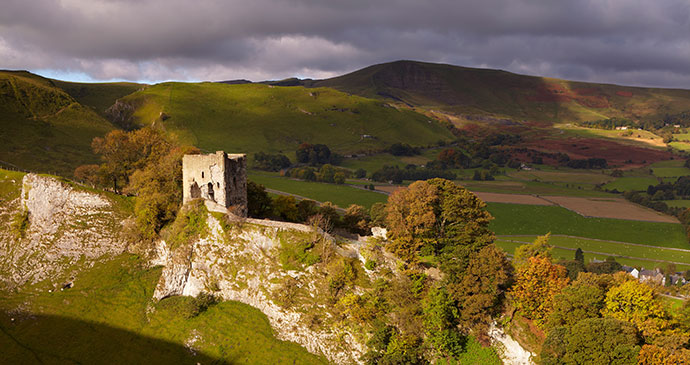
Tucked away in one corner of the keep, there’s a garderobe – a medieval toilet, a hole that drops away to ground far below it. Judging by the less than sweet aroma, modern-day visitors have been trying it out. History apart, it’s well worth the effort of making the steep ascent to the castle for the extensive and rather lovely views over to Cavedale, Castleton, the Hope Valley, Mam Tor and the wider Dark Peak.
Someries Castle, Bedfordshire
Few of the travellers who fly through the optimistically named London Luton Airport are aware that the ruins of Someries Castle lie just over a mile on foot from Luton Parkway Station – a remarkably peaceful walk, aside from the low-flying aircraft. This castle in the Northern Chilterns gets its name from the family who owned it in the 14th century, but the surviving structure was built for Sir John Wenlock.
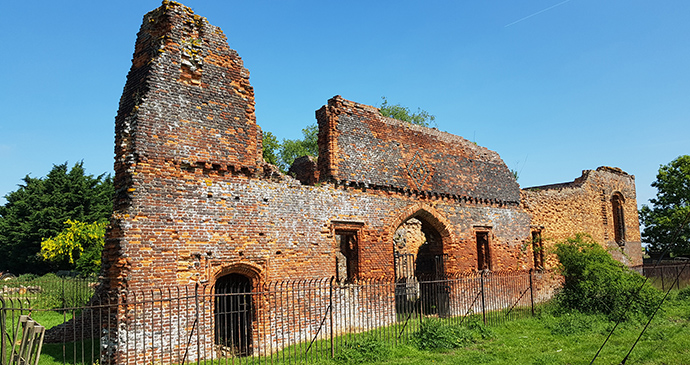
Admittedly it doesn’t look too much like the popular idea of a castle, since it comprises the remains of a 15th-century fortified manor house, one of the first to have been built from brick, at a time when architectural fashions were changing from defensive capability to domestic comfort. All that remains today are the gatehouse and part of the chapel. The novelist Joseph Conrad rented a nearby farmhouse for a couple of years while writing Under Western Eyes.
More information
For more of England’s finest ruins, take a look at our Slow Travel guides:

